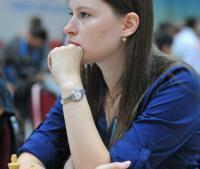
European Championship-2011
The 12th European Chess Championship was held in France and finished on April, 2nd. I couldn’t restrain myself from commentating on this great event. As my column is dedicated to preparing for international tournaments and playing in them, I will pay special attention to the tournament tactics of the winner and the other three players who shared first.
393 participants competed at the event. That is a huge number for a championship of this caliber. 85 grandmasters had a rating of 2600+, and many 2500+ GMs were surprised to find themselves in the middle of the starting ranking list for the first time in their [adult] lives. As there were only 23 qualification spots for the World Cup, you can guess yourself how hard it was to make it. As the number of competitors is high, one needs to score heavily to succeed. That involves knowing when to take a risk: the safe classical ‘win with White, draw with Black” strategy may not be good enough here. For example, it is not so easy to win with White all the time, or you may lose a slightly worse endgame with Black. Also, most tie-break scores (no tie-break matches this year!) favor players who had a good start. Therefore, starting out well is an important part of overall success. Of course, there are other options, but in this case one needs to win the event exclusively (so as to forget about tie-break scores).
As you probably know, the four grandmasters who shared first were: Vladimir Potkin (Russia), Radoslaw Wojtaszek (Poland), Judit Polgar (Hungary) and Alexandr Moiseenko (Ukraine), all of whom scored 8.5/11.

With Vladimir Potkin and Dmitry Jakovenko
Vladimir Potkin was declared the champion on tie-break scores, mainly due to winning 5 games in a row in rounds 1-5. After such a great start Vladimir could allow himself to make a few draws, and didn’t get swallowed by the “drawish bogs”. By defeating Baadur Jobava with Black in round 10, he has nearly ensured his victory.
Radoslaw Wojtasjzek, widely known for being Anand's second
Radoslaw Wojtasjzek got another trump in this tournament – the White pieces. In 7 out of 11 games he had White! That in inself doesn’t guarantee anything, but is a great factor for a strong GM. The higher the level, the more important it is what color you have. Winning with Black is tough, so most players rely on White. Radoslaw won “only” 4 out of 7 White games. Why only? Because even such an incredible performance was not good enough to topple Potkin.

Judit Polgar, a living legend
Judit Polgar got bronze at what is considered to be the Men’s European Championship (officially it’s called Individual, but there is a separate tournament for Women) – another record on her part. Her style is widely admired by chess fans: very active chess, attacking, although somewhat straightforward. Sometimes that leads to painful losses (like in the game vs Markus Ragger). Nowadays, when the overall chess level is getting higher and higher, it is very hard to win “on class” against lower-rated players. One has to take risks and play actively. Those who excel in this perform better in open events. Judit is a supreme example of a person who not only likes to play aggressive chess, but is extremely proficient in it. In this tournament Judit was pressing in all the games (except for a short draw in round 12), but avoided gambling too much.

With my long-time Ukrainian friends: Pavel Eljanov and Alexandr Moiseenko
Alexandr Moiseenko came 4th on tie-break scores. After having started with 3/3, he opted for an academic, risk-free style. On the one hand, he could have taken a risk (losing one game is not the end of it – see Polgar’s example; while winning a game would allow him to chase Potkin). On the other hand, some players prefer not to force matters and try to capitalize on weaker opponents in the last rounds. Unfortunately for Alexandr, he lost a game and made three draws, so the situation became “now or never”. By winning his three final games in a row GM Moiseenko clinched 1st, but his tie-breaks were not good enough.
The general impression is that all four GMs did a good job of balancing risks and winning ambitions. They followed wise strategies instead of desperately going all-out in each round. Vladimir Potkin had probably the most impressive tournament of them all (leading all the way) so his win looks justified.
To wrap this story up, I would like to share with you my annotation to a game played by the inimitable Judit Polgar. Her victory over Levan Pantzulaia has deeply impressed the international chess community:







